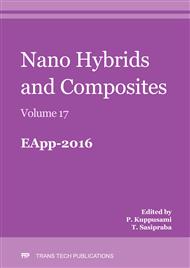p.171
p.179
p.194
p.202
p.217
p.224
p.237
p.246
p.256
A Comparative Study on Sintering Behaviour of Low and High Density Pellets of Ni-YSZ by Electrochemical Impedance Spectroscopy
Abstract:
In this study, a systematic investigation on in-situ sintering behavior of Ni-YSZ (50: 50wt. %) pellets of density of 4.2 (low density) and 4.9 g/cm3 (high density) in ambient and oxygen environment by impedance spectroscopy is presented. X-ray diffraction indicated the formation of cubic phases of NiO and YSZ. The low density pellet sintered for 16 h showed low content of monoclinic phase when compared to high density pellet. The microstructure of the high density pellet revealed finer and homogenous distribution of Ni in YSZ matrix due to longer sintering duration when compared with the low density pellet. AC impedance spectra were recorded for both low and high density pellets during sintering in ambient and oxygen environment in the temperature range 873-1173 K. The results indicate that for both the pellets, the impedance values decreased when sintering temperature increased from 873 to 1173 K in both ambient and oxygen environment. However, the impedance was low while sintering in oxygen atmosphere than in ambient. Besides these observation, impedance of the high density pellet was much lower than that of the low density pellet at all sintering temperature in both ambient and oxygen atmosphere. While the impedance decreased with increasing sintering temperature, the capacitance increased slowly in both the ambient and oxygen atmosphere. The change in the impedance behavior due to grain interior and grain boundaries is explained in relation with the microstructural changes that occur during sintering in different environments.
Info:
Periodical:
Pages:
237-245
Citation:
Online since:
August 2017
Keywords:
Price:
Сopyright:
© 2017 Trans Tech Publications Ltd. All Rights Reserved
Share:
Citation:


